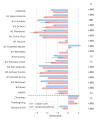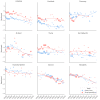Examining Rural and Urban Sentiment Difference in COVID-19-Related Topics on Twitter: Word Embedding-Based Retrospective Study
- PMID: 36790847
- PMCID: PMC9937112
- DOI: 10.2196/42985
Examining Rural and Urban Sentiment Difference in COVID-19-Related Topics on Twitter: Word Embedding-Based Retrospective Study
Abstract
Background: By the end of 2022, more than 100 million people were infected with COVID-19 in the United States, and the cumulative death rate in rural areas (383.5/100,000) was much higher than in urban areas (280.1/100,000). As the pandemic spread, people used social media platforms to express their opinions and concerns about COVID-19-related topics.
Objective: This study aimed to (1) identify the primary COVID-19-related topics in the contiguous United States communicated over Twitter and (2) compare the sentiments urban and rural users expressed about these topics.
Methods: We collected tweets containing geolocation data from May 2020 to January 2022 in the contiguous United States. We relied on the tweets' geolocations to determine if their authors were in an urban or rural setting. We trained multiple word2vec models with several corpora of tweets based on geospatial and timing information. Using a word2vec model built on all tweets, we identified hashtags relevant to COVID-19 and performed hashtag clustering to obtain related topics. We then ran an inference analysis for urban and rural sentiments with respect to the topics based on the similarity between topic hashtags and opinion adjectives in the corresponding urban and rural word2vec models. Finally, we analyzed the temporal trend in sentiments using monthly word2vec models.
Results: We created a corpus of 407 million tweets, 350 million (86%) of which were posted by users in urban areas, while 18 million (4.4%) were posted by users in rural areas. There were 2666 hashtags related to COVID-19, which clustered into 20 topics. Rural users expressed stronger negative sentiments than urban users about COVID-19 prevention strategies and vaccination (P<.001). Moreover, there was a clear political divide in the perception of politicians by urban and rural users; these users communicated stronger negative sentiments about Republican and Democratic politicians, respectively (P<.001). Regarding misinformation and conspiracy theories, urban users exhibited stronger negative sentiments about the "covidiots" and "China virus" topics, while rural users exhibited stronger negative sentiments about the "Dr. Fauci" and "plandemic" topics. Finally, we observed that urban users' sentiments about the economy appeared to transition from negative to positive in late 2021, which was in line with the US economic recovery.
Conclusions: This study demonstrates there is a statistically significant difference in the sentiments of urban and rural Twitter users regarding a wide range of COVID-19-related topics. This suggests that social media can be relied upon to monitor public sentiment during pandemics in disparate types of regions. This may assist in the geographically targeted deployment of epidemic prevention and management efforts.
Keywords: COVID-19; Twitter; data; epidemic; machine learning; management; model; prevention; rural; sentiment analysis; social media; topic analysis; training; urban; vaccination; word embedding.
©Yongtai Liu, Zhijun Yin, Congning Ni, Chao Yan, Zhiyu Wan, Bradley Malin. Originally published in the Journal of Medical Internet Research (https://www.jmir.org), 15.02.2023.
Conflict of interest statement
Conflicts of Interest: None declared.
Figures






Similar articles
-
Tweet Topics and Sentiments Relating to COVID-19 Vaccination Among Australian Twitter Users: Machine Learning Analysis.J Med Internet Res. 2021 May 19;23(5):e26953. doi: 10.2196/26953. J Med Internet Res. 2021. PMID: 33886492 Free PMC article.
-
Topics, Trends, and Sentiments of Tweets About the COVID-19 Pandemic: Temporal Infoveillance Study.J Med Internet Res. 2020 Oct 23;22(10):e22624. doi: 10.2196/22624. J Med Internet Res. 2020. PMID: 33006937 Free PMC article.
-
Tracking Public Attitudes Toward COVID-19 Vaccination on Tweets in Canada: Using Aspect-Based Sentiment Analysis.J Med Internet Res. 2022 Mar 29;24(3):e35016. doi: 10.2196/35016. J Med Internet Res. 2022. PMID: 35275835 Free PMC article.
-
Methods for Social Media Monitoring Related to Vaccination: Systematic Scoping Review.JMIR Public Health Surveill. 2021 Feb 8;7(2):e17149. doi: 10.2196/17149. JMIR Public Health Surveill. 2021. PMID: 33555267 Free PMC article.
-
Evolution of Select Epidemiological Modeling and the Rise of Population Sentiment Analysis: A Literature Review and COVID-19 Sentiment Illustration.Int J Environ Res Public Health. 2022 Mar 9;19(6):3230. doi: 10.3390/ijerph19063230. Int J Environ Res Public Health. 2022. PMID: 35328916 Free PMC article. Review.
Cited by
-
Quantifying Disparities in COVID-19 Vaccination Rates by Rural and Urban Areas: Cross-Sectional Observational Study.JMIR Public Health Surveill. 2024 Jul 19;10:e50595. doi: 10.2196/50595. JMIR Public Health Surveill. 2024. PMID: 39028548 Free PMC article.
-
Fatigue, Pain, and Medication: Mining Online Posts Regarding Rheumatoid Arthritis From Reddit.AMIA Annu Symp Proc. 2024 Jan 11;2023:754-763. eCollection 2023. AMIA Annu Symp Proc. 2024. PMID: 38222419 Free PMC article.
-
Wastewater-Informed Digital Advertising as a COVID-19 Geotargeted Neighborhood Intervention: Jefferson County, Kentucky, 2021-2022.Am J Public Health. 2024 Jan;114(1):34-37. doi: 10.2105/AJPH.2023.307439. Epub 2023 Oct 19. Am J Public Health. 2024. PMID: 37856730 Free PMC article.
-
Using wastewater to overcome health disparities among rural residents.Geoforum. 2023 Aug;144:103816. doi: 10.1016/j.geoforum.2023.103816. Epub 2023 Jun 26. Geoforum. 2023. PMID: 37396346 Free PMC article.
-
COVID-19 Vaccine Hesitancy: A Global Public Health and Risk Modelling Framework Using an Environmental Deep Neural Network, Sentiment Classification with Text Mining and Emotional Reactions from COVID-19 Vaccination Tweets.Int J Environ Res Public Health. 2023 May 12;20(10):5803. doi: 10.3390/ijerph20105803. Int J Environ Res Public Health. 2023. PMID: 37239532 Free PMC article.
References
-
- COVID Data Tracker. Centers for Disease Control and Prevention. [2023-01-05]. https://covid.cdc.gov/covid-data-tracker .
-
- Covid-19 Dashboard for Rural America. Daily Yonder. [2023-01-05]. https://dailyyonder.com/covid-19-dashboard-for-rural-america/
-
- Cuadros DF, Branscum AJ, Mukandavire Z, Miller FD, MacKinnon N. Dynamics of the COVID-19 epidemic in urban and rural areas in the United States. Ann Epidemiol. 2021 Jul;59:16–20. doi: 10.1016/j.annepidem.2021.04.007. https://europepmc.org/abstract/MED/33894385 S1047-2797(21)00063-6 - DOI - PMC - PubMed
-
- Chauhan R, Silva DD, Salon D. COVID-19 related attitudes and risk perceptions across urban, rural, and suburban areas in the United States. Findings. 2021:23714. doi: 10.32866/001c.23714. https://findingspress.org/article/23714-covid-19-related-attitudes-and-r... - DOI
-
- Alcendor DJ. Targeting COVID vaccine hesitancy in rural communities in Tennessee: implications for extending the covid-19 pandemic in the South the COVID-19 Pandemic in the South. Vaccines (Basel) 2021 Nov 04;9(11):1279. doi: 10.3390/vaccines9111279. https://www.mdpi.com/resolver?pii=vaccines9111279 vaccines9111279 - DOI - PMC - PubMed
Publication types
MeSH terms
Grants and funding
LinkOut - more resources
Full Text Sources
Medical
Research Materials
Miscellaneous

